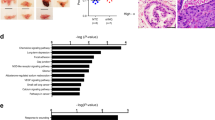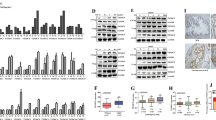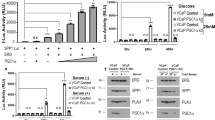Abstract
Nicotinamide phosphoribosyltransferase (NAMPT) is a rate-limiting enzyme in regenerating nicotinamide adenine dinucleotide (NAD+) from nicotinamide in mammals. NAMPT has crucial roles for many cellular functions by regulating NAD+-dependent SIRT1 deacetylase. However, roles of NAMPT in cancer are poorly defined. In this study, we show that NAMPT is prominently overexpressed in human prostate cancer cells along with SIRT1. Elevation of NAMPT expression occurs early for the prostate neoplasia. Inhibition of NAMPT significantly suppresses cell growth in culture, soft agar colony formation, cell invasion and growth of xenografted prostate cancer cells in mice. NAMPT knockdown sensitizes prostate cancer cells to oxidative stress caused by H2O2 or chemotherapeutic treatment. Overexpression of NAMPT increases prostate cancer cell resistance to oxidative stress, which is partially blocked by SIRT1 knockdown. We demonstrate that in addition to modulating SIRT1 functions, the NAMPT inhibition reduces forkhead box, class ‘O’ (FOXO)3a protein expression and its downstream anti-oxidant genes catalase and manganese superoxide dismutase. Our results suggest important roles of concomitant upregulation of NAMPT and SIRT1 along with increased FOXO3a protein level for prostate carcinogenesis and their contribution to oxidative stress resistance of prostate cancer cells. These findings may have implications for exploring the NAMPT pathway for prostate cancer prevention and treatment.
This is a preview of subscription content, access via your institution
Access options
Subscribe to this journal
Receive 50 print issues and online access
$259.00 per year
only $5.18 per issue
Buy this article
- Purchase on Springer Link
- Instant access to full article PDF
Prices may be subject to local taxes which are calculated during checkout









Similar content being viewed by others
References
Anderson RM, Bitterman KJ, Wood JG, Medvedik O, Sinclair DA . (2003). Nicotinamide and PNC1 govern lifespan extension by calorie restriction in Saccharomyces cerevisiae. Nature 423: 181–185.
Balaban RS, Nemoto S, Finkel T . (2005). Mitochondria, oxidants, and aging. Cell 120: 483–495.
Berrigan D, Perkins SN, Haines DC, Hursting SD . (2002). Adult-onset calorie restriction and fasting delay spontaneous tumorigenesis in p53-deficient mice. Carcinogenesis 23: 817–822.
Bitterman KJ, Anderson RM, Cohen HY, Latorre-Esteves M, Sinclair DA . (2002). Inhibition of silencing and accelerated aging by nicotinamide, a putative negative regulator of yeast sir2 and human SIRT1. J Biol Chem 277: 45099–45107.
Boily G, He XH, Pearce B, Jardine K, McBurney MW . (2009). SirT1-null mice develop tumors at normal rates but are poorly protected by resveratrol. Oncogene 28: 2882–2893.
Boily G, Seifert EL, Bevilacqua L, He XH, Sabourin G, Estey C et al. (2008). SirT1 regulates energy metabolism and response to caloric restriction in mice. PLoS ONE 3: e1759.
Bradbury CA, Khanim FL, Hayden R, Bunce CM, White DA, Drayson MT et al. (2005). Histone deacetylases in acute myeloid leukaemia show a distinctive pattern of expression that changes selectively in response to deacetylase inhibitors. Leukemia 19: 1751–1759.
Brunet A, Sweeney LB, Sturgill JF, Chua KF, Greer PL, Lin Y et al. (2004). Stress-dependent regulation of FOXO transcription factors by the SIRT1 deacetylase. Science 303: 2011–2015.
Busso N, Karababa M, Nobile M, Rolaz A, Van Gool F, Galli M et al. (2008). Pharmacological inhibition of nicotinamide phosphoribosyltransferase/visfatin enzymatic activity identifies a new inflammatory pathway linked to NAD. PLoS One 3: e2267.
Charvet C, Alberti I, Luciano F, Jacquel A, Bernard A, Auberger P et al. (2003). Proteolytic regulation of Forkhead transcription factor FOXO3a by caspase-3-like proteases. Oncogene 22: 4557–4568.
Chen WY, Cooper TK, Zahnow CA, Overholtzer M, Zhao Z, Ladanyi M et al. (2004). Epigenetic and genetic loss of Hic1 function accentuates the role of p53 in tumorigenesis. Cancer Cell 6: 387–398.
Chen WY, Wang DH, Yen RC, Luo J, Gu W, Baylin SB . (2005). Tumor suppressor HIC1 directly regulates SIRT1 to modulate p53-dependent DNA-damage responses. Cell 123: 437–448.
Chu F, Chou PM, Zheng X, Mirkin BL, Rebbaa A . (2005). Control of multidrug resistance gene mdr1 and cancer resistance to chemotherapy by the longevity gene sirt1. Cancer Res 65: 10183–10187.
Costello LC, Franklin RB . (2006). The clinical relevance of the metabolism of prostate cancer; zinc and tumor suppression: connecting the dots. Mol Cancer 5: 17.
Cressman VL, Backlund DC, Hicks EM, Gowen LC, Godfrey V, Koller BH . (1999). Mammary tumor formation in p53- and BRCA1-deficient mice. Cell Growth Differ 10: 1–10.
Dai Y, Ngo D, Forman LW, Qin DC, Jacob J, Faller DV . (2007). Sirtuin 1 is required for antagonist-induced transcriptional repression of androgen-responsive genes by the androgen receptor. Mol Endocrinol 21: 1807–1821.
Daitoku H, Hatta M, Matsuzaki H, Aratani S, Ohshima T, Miyagishi M et al. (2004). Silent information regulator 2 potentiates Foxo1-mediated transcription through its deacetylase activity. Proc Natl Acad Sci USA 101: 10042–10047.
De Marzo AM, Platz EA, Sutcliffe S, Xu J, Gronberg H, Drake CG et al. (2007). Inflammation in prostate carcinogenesis. Nat Rev Cancer 7: 256–269.
Drevs J, Loser R, Rattel B, Esser N . (2003). Antiangiogenic potency of FK866/K22.175, a new inhibitor of intracellular NAD biosynthesis, in murine renal cell carcinoma. Anticancer Res 23: 4853–4858.
Firestein R, Blander G, Michan S, Oberdoerffer P, Ogino S, Campbell J et al. (2008). The SIRT1 deacetylase suppresses intestinal tumorigenesis and colon cancer growth. PLoS ONE 3: e2020.
Ford J, Jiang M, Milner J . (2005). Cancer-specific functions of SIRT1 enable human epithelial cancer cell growth and survival. Cancer Res 65: 10457–10463.
Fu M, Liu M, Sauve AA, Jiao X, Zhang X, Wu X et al. (2006). Hormonal control of androgen receptor function through SIRT1. Mol Cell Biol 26: 8122–8135.
Fukuhara A, Matsuda M, Nishizawa M, Segawa K, Tanaka M, Kishimoto K et al. (2005). Visfatin: a protein secreted by visceral fat that mimics the effects of insulin. Science 307: 426–430.
Fulco M, Cen Y, Zhao P, Hoffman EP, McBurney MW, Sauve AA et al. (2008). Glucose restriction inhibits skeletal myoblast differentiation by activating SIRT1 through AMPK-mediated regulation of Nampt. Dev Cell 14: 661–673.
Garten A, Petzold S, Korner A, Imai S, Kiess W . (2009). Nampt: linking NAD biology, metabolism and cancer. Trends Endocrinol Metab 20: 130–138.
Gartner EM, Burger AM, Lorusso PM . (2010). Poly(adp-ribose) polymerase inhibitors: a novel drug class with a promising future. Cancer J 16: 83–90.
Grozinger CM, Chao ED, Blackwell HE, Moazed D, Schreiber SL . (2001). Identification of a class of small molecule inhibitors of the sirtuin family of NAD-dependent deacetylases by phenotypic screening. J Biol Chem 276: 38837–38843.
Harvey M, McArthur MJ, Montgomery Jr CA, Butel JS, Bradley A, Donehower LA . (1993). Spontaneous and carcinogen-induced tumorigenesis in p53-deficient mice. Nat Genet 5: 225–229.
Hasmann M, Schemainda I . (2003). FK866, a highly specific noncompetitive inhibitor of nicotinamide phosphoribosyltransferase, represents a novel mechanism for induction of tumor cell apoptosis. Cancer Res 63: 7436–7442.
Huffman DM, Grizzle WE, Bamman MM, Kim JS, Eltoum IA, Elgavish A et a.l (2007). SIRT1 is significantly elevated in mouse and human prostate cancer. Cancer Res 67: 6612–6618.
Hufton SE, Moerkerk PT, Brandwijk R, de Bruine AP, Arends JW, Hoogenboom HR . (1999). A profile of differentially expressed genes in primary colorectal cancer using suppression subtractive hybridization. FEBS Lett 463: 77–82.
Hwang CS, Shemorry A, Varshavsky A . (2010). N-terminal acetylation of cellular proteins creates specific degradation signals. Science 327: 973–977.
Jang KY, Hwang SH, Kwon KS, Kim KR, Choi HN, Lee NR et al. (2008). SIRT1 expression is associated with poor prognosis of diffuse large B-cell lymphoma. Am J Surg Pathol 32: 1523–1531.
Jang KY, Kim KS, Hwang SH, Kwon KS, Kim KR, Park HS et al. (2009). Expression and prognostic significance of SIRT1 in ovarian epithelial tumours. Pathology 41: 366–371.
Jung-Hynes B, Nihal M, Zhong W, Ahmad N . (2009). Role of sirtuin histone deacetylase SIRT1 in prostate cancer. A target for prostate cancer management via its inhibition? J Biol Chem 284: 3823–3832.
Karger S, Weidinger C, Krause K, Sheu SY, Aigner T, Gimm O et al. (2009). FOXO3a: a novel player in thyroid carcinogenesis? Endocr Relat Cancer 16: 189–199.
Kikuno N, Shiina H, Urakami S, Kawamoto K, Hirata H, Tanaka Y et al. (2008). Genistein mediated histone acetylation and demethylation activates tumor suppressor genes in prostate cancer cells. Int J Cancer 123: 552–560.
Kojima K, Ohhashi R, Fujita Y, Hamada N, Akao Y, Nozawa Y et al. (2008). A role for SIRT1 in cell growth and chemoresistance in prostate cancer PC3 and DU145 cells. Biochem Biophys Res Commun 373: 423–428.
Kops GJ, Dansen TB, Polderman PE, Saarloos I, Wirtz KW, Coffer PJ et al. (2002). Forkhead transcription factor FOXO3a protects quiescent cells from oxidative stress. Nature 419: 316–321.
Lain S, Hollick JJ, Campbell J, Staples OD, Higgins M, Aoubala M et al. (2008). Discovery, in vivo activity, and mechanism of action of a small-molecule p53 activator. Cancer Cell 13: 454–463.
Lee WH, Morton RA, Epstein JI, Brooks JD, Campbell PA, Bova GS et al. (1994). Cytidine methylation of regulatory sequences near the pi-class glutathione S-transferase gene accompanies human prostatic carcinogenesis. Proc Natl Acad Sci USA 91: 11733–11737.
Li Y, Xu W, McBurney MW, Longo VD . (2008). SirT1 inhibition reduces IGF-I/IRS-2/Ras/ERK1/2 signaling and protects neurons. Cell Metab 8: 38–48.
Lin SJ, Defossez PA, Guarente L . (2000). Requirement of NAD and SIR2 for life-span extension by calorie restriction in Saccharomyces cerevisiae. Science 289: 2126–2128.
Liu Y . (2006). Fatty acid oxidation is a dominant bioenergetic pathway in prostate cancer. Prostate Cancer Prostatic Dis 9: 230–234.
Luo J, Nikolaev AY, Imai S, Chen D, Su F, Shiloh A et al. (2001). Negative control of p53 by Sir2alpha promotes cell survival under stress. Cell 107: 137–148.
Modur V, Nagarajan R, Evers BM, Milbrandt J . (2002). FOXO proteins regulate tumor necrosis factor-related apoptosis inducing ligand expression. Implications for PTEN mutation in prostate cancer. J Biol Chem 277: 47928–47937.
Motta MC, Divecha N, Lemieux M, Kamel C, Chen D, Gu W et al. (2004). Mammalian SIRT1 represses forkhead transcription factors. Cell 116: 551–563.
Muruganandham M, Alfieri AA, Matei C, Chen Y, Sukenick G, Schemainda I et al. (2005). Metabolic signatures associated with a NAD synthesis inhibitor-induced tumor apoptosis identified by 1H-decoupled-31P magnetic resonance spectroscopy. Clin Cancer Res 11: 3503–3513.
Nakahata Y, Sahar S, Astarita G, Kaluzova M, Sassone-Corsi P . (2009). Circadian control of the NAD+ salvage pathway by CLOCK-SIRT1. Science 324: 654–657.
Nelson WG, De Marzo AM, Isaacs WB . (2003). Prostate cancer. N Engl J Med 349: 366–381.
Nemoto S, Fergusson MM, Finkel T . (2004). Nutrient availability regulates SIRT1 through a forkhead-dependent pathway. Science 306: 2105–2108.
Nemoto S, Finkel T . (2002). Redox regulation of forkhead proteins through a p66shc-dependent signaling pathway. Science 295: 2450–2452.
Nosho K, Shima K, Irahara N, Kure S, Firestein R, Baba Y et al. (2009). SIRT1 histone deacetylase expression is associated with microsatellite instability and CpG island methylator phenotype in colorectal cancer. Mod Pathol 22: 922–932.
Oberdoerffer P, Michan S, McVay M, Mostoslavsky R, Vann J, Park SK et al. (2008). SIRT1 redistribution on chromatin promotes genomic stability but alters gene expression during aging. Cell 135: 907–918.
Ognjanovic S, Bao S, Yamamoto SY, Garibay-Tupas J, Samal B, Bryant-Greenwood GD . (2001). Genomic organization of the gene coding for human pre-B-cell colony enhancing factor and expression in human fetal membranes. J Mol Endocrinol 26: 107–117.
Ota H, Tokunaga E, Chang K, Hikasa M, Iijima K, Eto M et al. (2006). Sirt1 inhibitor, Sirtinol, induces senescence-like growth arrest with attenuated Ras-MAPK signaling in human cancer cells. Oncogene 25: 176–185.
Plas DR, Thompson CB . (2003). Akt activation promotes degradation of tuberin and FOXO3a via the proteasome. J Biol Chem 278: 12361–12366.
Ramsey KM, Yoshino J, Brace CS, Abrassart D, Kobayashi Y, Marcheva B et al. (2009). Circadian clock feedback cycle through NAMPT-mediated NAD+ biosynthesis. Science 324: 651–654.
Revollo JR, Grimm AA, Imai S . (2004). The NAD biosynthesis pathway mediated by nicotinamide phosphoribosyltransferase regulates Sir2 activity in mammalian cells. J Biol Chem 279: 50754–50763.
Revollo JR, Korner A, Mills KF, Satoh A, Wang T, Garten A et al. (2007). Nampt/PBEF/Visfatin regulates insulin secretion in beta cells as a systemic NAD biosynthetic enzyme. Cell Metab 6: 363–375.
Samal B, Sun Y, Stearns G, Xie C, Suggs S, McNiece I . (1994). Cloning and characterization of the cDNA encoding a novel human pre-B-cell colony-enhancing factor. Mol Cell Biol 14: 1431–1437.
Saunders LR, Verdin E . (2007). Sirtuins: critical regulators at the crossroads between cancer and aging. Oncogene 26: 5489–5504.
Schreiber V, Dantzer F, Ame JC, de Murcia G . (2006). Poly(ADP-ribose): novel functions for an old molecule. Nat Rev Mol Cell Biol 7: 517–528.
Shukla S, Shukla M, Maclennan GT, Fu P, Gupta S . (2009). Deregulation of FOXO3A during prostate cancer progression. Int J Oncol 34: 1613–1620.
Skokowa J, Lan D, Thakur BK, Wang F, Gupta K, Cario G et al. (2009). NAMPT is essential for the G-CSF-induced myeloid differentiation via a NAD(+)-sirtuin-1-dependent pathway. Nat Med 15: 151–158.
Trachootham D, Zhou Y, Zhang H, Demizu Y, Chen Z, Pelicano H et al. (2006). Selective killing of oncogenically transformed cells through a ROS-mediated mechanism by beta-phenylethyl isothiocyanate. Cancer Cell 10: 241–252.
Turkbey B, Pinto PA, Choyke PL . (2009). Imaging techniques for prostate cancer: implications for focal therapy. Nat Rev Urol 6: 191–203.
Van Beijnum JR, Moerkerk PT, Gerbers AJ, De Bruine AP, Arends JW, Hoogenboom HR et al. (2002). Target validation for genomics using peptide-specific phage antibodies: a study of five gene products overexpressed in colorectal cancer. Int J Cancer 101: 118–127.
van der Veer E, Ho C, O′Neil C, Barbosa N, Scott R, Cregan SP et al. (2007). Extension of human cell lifespan by nicotinamide phosphoribosyltransferase. J Biol Chem 282: 10841–10845.
Vaziri H, Dessain SK, Ng Eaton E, Imai SI, Frye RA, Pandita TK et al. (2001). hSIR2(SIRT1) functions as an NAD-dependent p53 deacetylase. Cell 107: 149–159.
Venkatachalam S, Shi YP, Jones SN, Vogel H, Bradley A, Pinkel D et al. (1998). Retention of wild-type p53 in tumors from p53 heterozygous mice: reduction of p53 dosage can promote cancer formation. Embo J 17: 4657–4667.
Wang RH, Sengupta K, Li C, Kim HS, Cao L, Xiao C et al. (2008). Impaired DNA damage response, genome instability, and tumorigenesis in SIRT1 mutant mice. Cancer Cell 14: 312–323.
Warburg O . (1931). The Metabolism of Tumors. Smith RR: New York.
Watson M, Roulston A, Belec L, Billot X, Marcellus R, Bedard D et al. (2009). The small molecule GMX1778 is a potent inhibitor of NAD+ biosynthesis: strategy for enhanced therapy in nicotinic acid phosphoribosyltransferase 1-deficient tumors. Mol Cell Biol 29: 5872–5888.
Williams AC, Ramsden DB . (2005). Autotoxicity, methylation and a road to the prevention of Parkinson's disease. J Clin Neurosci 12: 6–11.
Xiao D, Lew KL, Zeng Y, Xiao H, Marynowski SW, Dhir R et al. (2006). Phenethyl isothiocyanate-induced apoptosis in PC-3 human prostate cancer cells is mediated by reactive oxygen species-dependent disruption of the mitochondrial membrane potential. Carcinogenesis 27: 2223–2234.
Yang H, Yang T, Baur JA, Perez E, Matsui T, Carmona JJ et al. (2007). Nutrient-sensitive mitochondrial NAD(+) levels dictate cell survival. Cell 130: 1095–1107.
Ye SQ, Simon BA, Maloney JP, Zambelli-Weiner A, Gao L, Grant A et al. (2005). Pre-B-cell colony-enhancing factor as a potential novel biomarker in acute lung injury. Am J Respir Crit Care Med 171: 361–370.
Yu SW, Andrabi SA, Wang H, Kim NS, Poirier GG, Dawson TM et al. (2006). Apoptosis-inducing factor mediates poly(ADP-ribose) (PAR) polymer-induced cell death. Proc Natl Acad Sci USA 103: 18314–18319.
Acknowledgements
This study is supported by the start-up fund from City of Hope, career development award from STOPCANCER foundation and research scholar award from American Cancer Society (WYC). EA was supported by a training grant awarded to CSULB from California Institute of Regenerative Medicine.
Author information
Authors and Affiliations
Corresponding author
Ethics declarations
Competing interests
The authors declare no conflict of interest.
Additional information
Supplementary Information accompanies the paper on the Oncogene website
Supplementary information
Rights and permissions
About this article
Cite this article
Wang, B., Hasan, M., Alvarado, E. et al. NAMPT overexpression in prostate cancer and its contribution to tumor cell survival and stress response. Oncogene 30, 907–921 (2011). https://doi.org/10.1038/onc.2010.468
Received:
Revised:
Accepted:
Published:
Issue Date:
DOI: https://doi.org/10.1038/onc.2010.468
Keywords
This article is cited by
-
NAD pool as an antitumor target against cancer stem cells in head and neck cancer
Journal of Experimental & Clinical Cancer Research (2023)
-
FK866 inhibits colorectal cancer metastasis by reducing NAD+ levels in cancer-associated fibroblasts
Genes & Genomics (2022)
-
Mapping genetic variability in mature miRNAs and miRNA binding sites in prostate cancer
Journal of Human Genetics (2021)
-
NAD+ metabolism, stemness, the immune response, and cancer
Signal Transduction and Targeted Therapy (2021)
-
Targeting the NAD+ salvage pathway suppresses APC mutation-driven colorectal cancer growth and Wnt/β-catenin signaling via increasing Axin level
Cell Communication and Signaling (2020)



